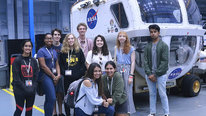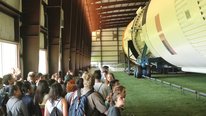- Margaret Baguio
- http://www.tsgc.utexas.edu/info/baguio.html
- Program Manager - Education and Outreach
- Presenter’s NSFRESOURCECENTERS
- Texas Space Grant Consortium, University of Texas at Austin
- Tim Urban
- Director
- Presenter’s NSFRESOURCECENTERS
- Texas Space Grant Consortium, University of Texas at Austin
STEM Enhancement in Earth Science
NNX16AB89A
2019 (see original presentation & discussion)
Grades 9-12
Well-documented trends have been reported nationally of declining interest, poor preparedness, a lack of diverse representation, and low persistence of U.S. students in Science, Technology, Engineering and Mathematics (STEM) disciplines. SEES addresses the national need to increase the number of high school students, particularly under-represented minorities and those from underserved areas that will pursue STEM college degrees. Through a partnership of institutions and organizations we will use NASA’s earth observing satellites as a catalyst for the development of an Earth Science high school curriculum to be offered online and to implement a high school student internship program. The SEES program 1) utilizes NASA facilities and assets to provide work experience, research, and educational opportunities for high school students to encourage STEM careers and preparation; 2) provide opportunities for students and teachers to participate in experiential learning activities that will connect learners to NASA-unique resources in Earth Science; and 3) prepare STEM educators and leaders to deliver quality STEM instruction utilizing NASA assets and content.
The project directly addresses NASA’s education mission goal to attract and retain students in STEM disciplines; contributes to enabling STEM education through mentorship, selection of existing NASA content supporting STEM and the opportunity for high school students and teachers to conduct authentic NASA mission-based research; improves U.S. scientific literacy by integrating identified lessons and data; advances national education goals by utilizing NASA resources that align with the Framework for K-12 Science Education; and leverages efforts through partnerships by drawing upon the strengths of project collaborators.
Related Content for STEM Enhancement in Earth Science Internship
-
 2018NASA STEM Enhancement in Earth Science H.S. Internship
2018NASA STEM Enhancement in Earth Science H.S. Internship
Margaret Baguio
-
 2022Growing Beyond Earth: Kids Contributing to NASA Research
2022Growing Beyond Earth: Kids Contributing to NASA Research
Amy Padolf
-
 2021Value of Authentic Research During COVID through NASA SEES
2021Value of Authentic Research During COVID through NASA SEES
Margaret Baguio
-
 2019GLOBE Mission EARTH: Inspiring Tomorrow's STEM Professionals
2019GLOBE Mission EARTH: Inspiring Tomorrow's STEM Professionals
Sara Mierzwiak
-
 2022Value of Authentic Research for All High School Students
2022Value of Authentic Research for All High School Students
Margaret Baguio
-
 2020Value of Authentic Research Experiences for HS Students
2020Value of Authentic Research Experiences for HS Students
Margaret Baguio
-
 2018NISE Network’s Space & Earth Informal STEM Education Project
2018NISE Network’s Space & Earth Informal STEM Education Project
Brad Herring
-
 2020GLOBE Mission EARTH: Inspiring tomorrow's STEM Professionals
2020GLOBE Mission EARTH: Inspiring tomorrow's STEM Professionals
Sara Mierzwiak


Margaret Baguio
Program Manager - Education and Outreach
The STEM Enhancement in Earth Science internship program is a collaboration between NASA, The University of Texas at Austin, and Texas Space Grant Consortium. Students complete 60 hours of remote work to increase their understanding of earth and space science, and 30 hours of work that is geared specifically toward their specific project. Students then participate in a two week on-site internship at the university where they are mentored by NASA subject matter experts participating in an authentic research experience.
In this video, produced by a former intern, we hear from former participants about how this experience guided the student into selecting college degrees, how the internship assisted in focusing on college majors, and the excitement in participating in a NASA-related internship.
We are interested in research about STEM experiences that help guide career choice among high school students.
Pranav Rajan
David Campbell
Program Officer (retired)
The students obviously enjoyed the experience! But I only heard two students discuss computer science projects. Can you provide examples of projects that specifically addressed earth and/or space science?
Margaret Baguio
Program Manager - Education and Outreach
While most students have computer coding and analysis as part of their project, many also focus on earth and space science. Here are a few examples:
Disaster Research with Mid-American Geospatial information Center - Disaster Map Using Satellites for Emergency Preparedness. Interns focus on recent flood, wildfire, or tropical storm event, review satellite image datasets from NASA, the European Space Agency, and the US Geological Survey collected before, during and after the event, and test best practices for rapid information extraction fro these data.
Flood Response - Interns compare National Weather Service Quantitative Precipitation Estimation OPE) products derived from Radar with rainfall gauge values collected in the same time and space. Interns develop Python scripts to automate the transformation of QPE point data into an interpolated gridded surface that can be tiled for rapid consumption by web-based mapping applications via rest endpoints.
Weighing Where the Water Goes - Interns analyze data from GRACE (Gravity Recovery and Climate Experiment), twin satellites, analyzing Earth's water resources over land, ice, and oceans.
Measuring Ice Sheet Changes - Interns examine climate data over Greenland and Antarctica from ICESat (2003-09) and ICESat-2 (2018) and other satellites. Analyses includes data visualization, satellite calibration, and comparisons with other measurement globally over ice sheets, sea ice, land, vegetation, and ocean/water surfaces.
Mary Murphy
Instructor
It seems like the program really helped students think both more broadly about career pathways while also giving deeper insight into specific types of work that NASA does. This is great! I, like David, would love to hear about specific projects students worked on. What did they learn from their projects? I am also interested in knowing how competitive was the pool of applicants? Seems like you had some geographic diversity (NJ, AK, SC, etc), did you also have socio-economic diversity?
Margaret Baguio
Program Manager - Education and Outreach
The projects are geared around topical areas:
Space Research - which includes Science on the International Space Station and Identifying Near Earth Asteroids
Disaster Research with the MAGIC (Mid-American Geospatial Information Center) - which includes Disaster Map: Using Satellites for Emergency Preparedness and Flood Response
Climate Research - which includes Weighing Where the Water Goes (GRACE) and Measuring Ice Sheet Changes (ICESat)
Mission Design - which includes Observing Earth from Space (aerospace engineering), Explore the Moon (spectral effects of space weathering and impact gardening on the evolution of lunar soil using remote sensing data), and Mars Exploration (infrastructure for Mars Exploration).
Students report on their research and findings during a livestream presentation the last day of the internship. They share project results, value of the internship, and future plans. They also have an opportunity during the two weeks they are on-site to hear from project scientists and engineers about other projects.
Often students arrive, thinking they want to major in a particular area, and after working on a project find they really engaged and interested in another area.
One of our challenges, which we are currently making plans for in the future, is how to include more students. We had 600 applications for 50 internships this year. It is heartbreaking to turn away smart, talented, and motivated students. The students come from across the U.S. and are socio-economically diverse. We have had students from all walks of life involved - homeless, children of migrant farmers, rural, inner-city, etc. This year almost 65% of those selected are girls.
It is definitely exciting to hear from former interns about where they are accepted into college, their majors, and other internships in which they have participated while in college. The young lady who produced the video is majoring in aerospace engineering and interned at the Jet Propulsion Lab last summer analyzing Cassini data.
Pranav Rajan
Roxana Jimenez
Experiencing the SEES Internship Program as an Educator truly broadened my understanding of the intricacy to which each STEM Branch not only contributes, but influences each decision needed to be made in order to successfully complete a mission. It was a wonderful experience as a Teacher Extern; must be even more amazing as a young adult considering Space Exploration.
Margaret Baguio
Program Manager - Education and Outreach
Thanks Roxanne! You were a great addition to our SEES internship. Having teachers explore all the different careers in the space industry added a new dimension to the program.
Jacob Grohs
Assistant Professor
Thanks for sharing! It seems like a good portion of work is completed in preparation for the on-site internship. Building an engaging curriculum remotely to include fostering some connection among participants ahead of time can be challenging but very important. What was the nature of the remote work and how student participants interface with the project prior to the internship?
Margaret Baguio
Program Manager - Education and Outreach
The remote work is three-fold. We have a tutorial that includes background on NASA earth science missions, videos about research at NASA, articles to read, and tasks to complete so students gain an understanding of NASA's mission. The students must answer questions and complete assignments in order to receive a certificate for each component. The second piece is a tutorial on computer coding. Many of our projects require coding so it is important to hone those skills prior to the on-site training. The third piece is led by the NASA subject matter expert. Each mentor uses a different format for their team such as google classroom or Edmoto. This is where the teambuilding starts. Students gain an understanding of what they are to accomplish during the on-site internship, communicate with their team members and mentors, and begin project plans.
Mary Murphy
Instructor
I am wondering about the remote work. Is it possible that some of this could be available to students regardless of whether they were to participate in the internships? I have so many students that would love to have an interaction and do some work that was aligned with NASA goals. Or is there still a lot of remote coaching and there would be a capacity issue?
Margaret Baguio
Program Manager - Education and Outreach
That is a wonderful idea and it is our hope to expand this internship in the future. Every student who applies is motivated, engaged, and passionate about a future in STEM. All would benefit from the program. It is heartbreaking for me to tell 500 students they cannot participate. This may be an option for students to feel connected. We "score" and provide feedback to all remote activities so it would take more manpower. The alternates selected this year are participating in all remote activities this year in the event that a student has to withdraw at the last minute. It will be interesting to see if those alternates feel alienated by not joining the on-site piece.
We do invite students that are not accepted to the on-site internship to participate in the GLOBE Mosquito Mapper project. They will join NASA scientists on webinars about their research, receive training, and we send them a magnifier to use on their phones to conduct their investigation. We have 175 of the applicants for SEES participating in this project.
Margaret Baguio
Program Manager - Education and Outreach
As we are always seeking ways to improve our project, we are interested in hearing from other programs that have an internship component.
Further posting is closed as the event has ended.